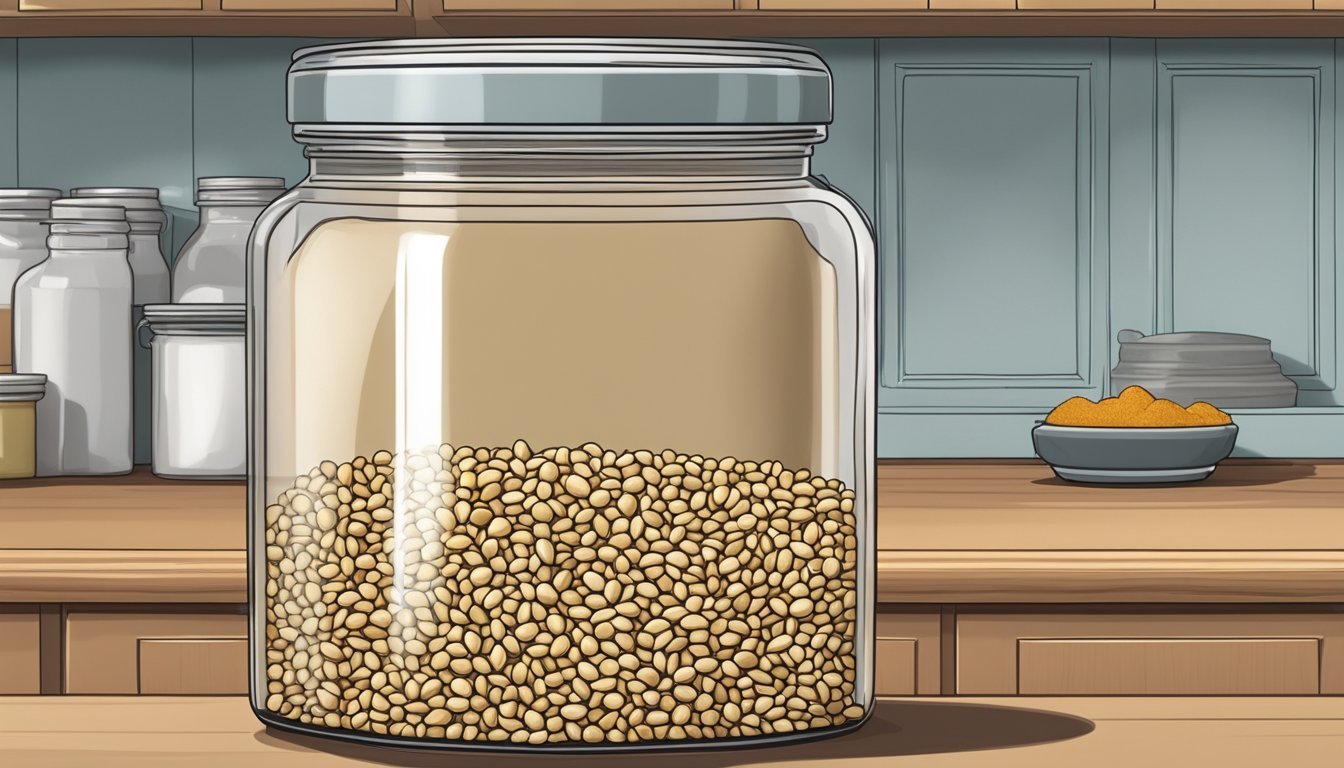How Long Do Sesame Seeds Last?
Shelf Life and Storage Tips
Sesame seeds (how long do sesame seeds last?) are a popular ingredient used across various cuisines for their nutty flavor and health benefits, which include being a good source of protein and healthy fats. However, like most natural products, they do not last indefinitely. Factors that affect the shelf life of sesame seeds include whether they are raw or roasted and if they are stored hulled or unhulled.
The quality and freshness of sesame seeds are contingent upon proper storage. They should be kept in a cool, dark, and dry place to maintain their integrity. An airtight container or tightly sealed bag can significantly extend their longevity by protecting them from moisture and other contaminants. Roasted sesame seeds generally have a shorter shelf life compared to their raw counterparts due to the oils being more exposed to oxidation.
To maximize the lifespan of sesame seeds, some users choose to store them in the refrigerator or freezer. This method of storage can extend the freshness of the seeds significantly, making them last several months to even a year, depending on whether they are kept in the pantry, refrigerator, or freezer. It's essential to monitor the seeds for any signs of spoilage, such as an off smell or taste, before use.
Understanding Sesame Seeds
Sesame seeds are prized for their rich nutty flavor and versatility in recipes. Rich in nutrients, they offer various health benefits and are used in many culinary applications worldwide.
Types and Nutritional Value
There are different types of sesame seeds, primarily distinguished by color, such as white, black, brown, and red. Each type offers a slightly distinct flavor and nutritional profile. Generally, sesame seeds are a good source of protein, healthy fats, fiber, and important minerals like iron, magnesium, and calcium.
White Sesame Seeds: Mild and nutty, commonly used in baking and for garnishing.
Black Sesame Seeds: (how long do black sesame seeds last?) Stronger in flavor, popular in Asian cuisine.
Brown Sesame Seeds: Often found in Middle Eastern dishes.
Red Sesame Seeds: Less common, with a slightly bitter taste.
The following table outlines the nutritional value of 1 ounce (28 grams) of sesame seeds:
Nutrient Amount Calories 160 Protein 5g Fat 13.5g Fiber 3g Iron 4% of RDI Magnesium 25% of RDI Calcium 35% of RDI
Health Benefits
Sesame seeds are known for their health benefits due to their impressive nutrient content. They are abundant in antioxidants, which help protect the body from oxidative damage. The seeds also contain lignans, compounds that may have cholesterol-lowering properties. Regular consumption of sesame seeds may contribute to cardiovascular health, support strong bones, and aid in digestion.
Common Uses in Recipes
Sesame seeds are widely used in a plethora of dishes, enhancing flavor and adding a textural element. Tahini, a paste made from sesame seeds, is a key ingredient in hummus and other Middle Eastern specialties. Sesame oil (how long does sesame oil last?) is cherished for its intense aroma and is an essential component of many Asian recipes. Here's a brief list of common uses:
As a topping on baked goods like bread and bagels (how long do bagels last?) for a nutty crunch.
Incorporated into granola bars for added texture and flavor.
Ground into tahini for dips, dressings, and sauces.
Sprinkled over stir-fries and salads for an extra burst of flavor and nutrients.
Shelf Life and Expiration
When it comes to sesame seeds, understanding their shelf life and how to identify expiration is essential for maintaining their quality and safety. Proper storage can significantly extend their usability, while signs of spoilage are telltale indicators that the seeds are no longer good to consume.
General Shelf Life
Sesame seeds enjoy a long shelf life when stored in cool, dry conditions. Typically, unopened packages of sesame seeds can last up to two years, whereas opened sesame seeds may remain fresh for:
Pantry: 3 to 6 months
Refrigerator: Up to 1 year
Freezer: 6 months
Note: These durations are estimates and can be influenced by factors such as storage conditions and the best by date.
Signs of Spoilage
Sesame seeds that have gone bad may exhibit several signs of spoilage:
Odor: A rancid smell is a clear sign that the seeds are spoiled.
Taste: If they have a sour or bitter taste, do not consume them.
Texture: Seeds that feel sticky or oily may indicate rancidity.
Mold: Any signs of moldy growth mean the sesame seeds should be discarded.
Determining Sesame Seed Quality
To assess if sesame seeds are still of good quality, one should perform a simple taste test. If the seeds taste as they should—nutty and crunchy—they are likely still good. Additionally, the absence of a rancid odor and mold signifies that the seeds maintain their quality. It is also crucial to check the expiration date if available, as consuming seeds past this date may carry health risks.
Proper Storage Techniques
To maximize the shelf life and maintain the quality of sesame seeds, it is crucial to employ proper storage techniques. Attention to temperature control, sealing, and choice of storage location can significantly prolong freshness.
Storage Environment
Temperature and humidity are key factors influencing the longevity of sesame seeds. They should be kept in a cool, dry place to hinder the growth of mold and prevent rancidity. Exposure to high levels of moisture, sunlight, or heat can degrade sesame seeds quickly.
Pantry vs. Refrigerator vs. Freezer
Pantry: For short-term storage, a pantry or cupboard away from heat sources is adequate. Expect a shelf life of several months for unopened sesame seeds.
Refrigerator: Refrigeration can extend a seed's lifespan. Sealed and refrigerated sesame seeds can last up to a year or more.
Freezer: For the longest storage, freezing sesame seeds in an airtight container can substantially extend freshness. Frozen sesame seeds can last for multiple years, but it is important to ensure they are completely dry before freezing to avoid ice crystal formation.
Containers and Packaging
To maintain sesame seed quality, packaging is critical:
Use an airtight container with a tight-fitting lid or a freezer bag to protect against moisture and air exposure.
If storing in the refrigerator or freezer, ensure seeds are placed in a sealable bag or container to guard against odors.
Extending Shelf Life
Proper methods of processing and storing sesame seeds significantly impact their quality and shelf life. Roasting and proper storage are key techniques to preserving both the flavor and nutritional value of sesame seeds.
Roasting and Toasting
Roasting or toasting sesame seeds can enhance their taste and extend their shelf life. Roasted sesame seeds typically last three to six months in the pantry and up to one year if stored in the refrigerator. However, it's important to note that roasting may reduce the oil content and potentially affect certain heat-sensitive nutrients.
To extend shelf life:
Roast sesame seeds in a dry pan over medium heat until golden.
Cool them completely before storing.
Making and Storing Sesame Products
Tahini, a product made from sesame seeds, and sesame seed oil also benefit from proper storage to maintain quality and extend shelf life.
For Tahini:
Store in an airtight container.
Keep it in the refrigerator to last about one year.
For Sesame Seed Oil:
Keep the oil in a cool, dark place to prevent rancidity.
If refrigerated, it can last up to three years.
Freezing sesame seeds can extend their freshness up to five years. It is crucial to use an airtight container or freezer bag to prevent moisture and freezer burn.
By following these roasting guidelines and storage tips, one can enjoy the rich flavor and nutritional benefits of sesame seeds for an extended period.
Frequently Asked Questions
This section addresses common concerns surrounding the shelf life of sesame seeds, how to detect spoilage, and allergy-related questions.
Usage and Substitution
Raw sesame seeds have a different shelf life than roasted sesame seeds. While raw seeds can last around two years when stored properly, roasted seeds should be used sooner as the roasting process shortens their lifespan. If a recipe calls for sesame seeds and they have run out or expired, similar seeds like poppy seeds (how long do poppy seeds last?) or finely chopped nuts may serve as a substitute. It's important to check the label for an expiry date to estimate how long the seeds will retain their nutritional value and sweet, nutty flavor.
Dealing with Spoilage and Contaminants
Sesame seeds can spoil or become contaminated with moldy spots, bugs, or pantry pests like larvae. Spoiled sesame seeds might have a bitter taste or smell like nail polish remover. To reduce the risk of digestive issues or the presence of harmful bacteria, one should ensure that sesame seeds are stored in a cool, dry place, preferably in a tightly sealed container to prevent contamination. If the seeds are already contaminated, they must be discarded to avoid health risks.
Allergy Information
An allergy to sesame seeds can manifest as hives, difficulty breathing, or swelling in individuals who are allergic. It's vital to be aware of the presence of sesame seeds in products, especially for those with a known allergy. If an allergic reaction occurs, the individual should seek medical attention immediately. Manufacturers like Bob's Red Mill often label their products clearly to help consumers with allergies avoid exposure.





